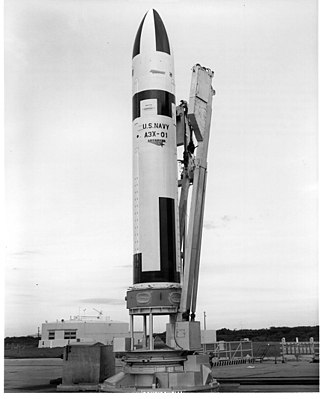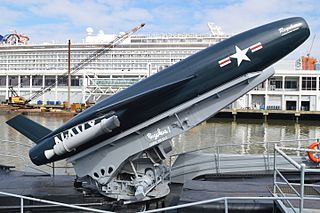Related Research Articles

The RUR-5 ASROC is an all-weather, all sea-conditions anti-submarine missile system. Developed by the United States Navy in the 1950s, it was deployed in the 1960s, updated in the 1990s, and eventually installed on over 200 USN surface ships, specifically cruisers, destroyers, and frigates. The ASROC has been deployed on scores of warships of many other navies, including Canada, Germany, Italy, Japan, the Republic of China, Greece, Pakistan and others.

The UGM-27 Polaris missile was a two-stage solid-fueled nuclear-armed submarine-launched ballistic missile (SLBM). As the United States Navy's first SLBM, it served from 1961 to 1980.

The Seawolf class is a class of nuclear-powered, fast attack submarines (SSN) in service with the United States Navy. The class was the intended successor to the Los Angeles class, and design work began in 1983. A fleet of 29 submarines was to be built over a ten-year period, but that was reduced to 12 submarines. The end of the Cold War and budget constraints led to the cancellation of any further additions to the fleet in 1995, leaving the Seawolf class limited to just three boats. This, in turn, led to the design of the smaller Virginia class. The Seawolf class cost about $3 billion per unit, making it the most expensive United States Navy fast attack submarine and second most expensive submarine ever, after the French Triomphant-class nuclear-powered ballistic missile submarines.

The Trident missile is a submarine-launched ballistic missile (SLBM) equipped with multiple independently targetable reentry vehicles (MIRV). Originally developed by Lockheed Missiles and Space Corporation, the missile is armed with thermonuclear warheads and is launched from nuclear-powered ballistic missile submarines (SSBNs). Trident missiles are carried by twelve United States Navy Ohio-class submarines, with American warheads, as well as four Royal Navy Vanguard-class submarines, with British warheads. The missile is named after the mythological trident of Neptune.

The TomahawkLand Attack Missile (TLAM) is a long-range, all-weather, jet-powered, subsonic cruise missile that is primarily used by the United States Navy and Royal Navy in ship and submarine-based land-attack operations.

The SSM-N-8A Regulus or the Regulus I was a United States Navy-developed ship-and-submarine-launched, nuclear-capable turbojet-powered second generation cruise missile, deployed from 1955 to 1964. Its development was an outgrowth of U.S. Navy tests conducted with the German V-1 missile at Naval Air Station Point Mugu in California. Its barrel-shaped fuselage resembled that of numerous fighter aircraft designs of the era, but without a cockpit. Test articles of the Regulus were equipped with landing gear and could take off and land like an airplane. When the missiles were deployed they were launched from a rail launcher, and equipped with a pair of Aerojet JATO bottles on the aft end of the fuselage.

A submarine-launched missile is a missile that can be launched from a submarine. They include submarine-launched ballistic missiles (SLBMs) and submarine-launched cruise missiles (SLCMs). SLBMs are launched vertically; some other types are fired through the submarine's torpedo tubes.

A ballistic missile submarine is a submarine capable of deploying submarine-launched ballistic missiles (SLBMs) with nuclear warheads. These submarines became a major weapon system in the Cold War because of their nuclear deterrence capability. They can fire missiles thousands of kilometers from their targets, and acoustic quieting makes them difficult to detect, thus making them a survivable deterrent in the event of a first strike and a key element of the mutual assured destruction policy of nuclear deterrence.

The 46 Knox-class frigates were the largest, last, and most numerous of the US Navy's second-generation anti-submarine warfare (ASW) escorts. Originally laid down as ocean escorts, they were all redesignated as frigates on 30 June 1975, in the 1975 ship reclassification plan and their hull designation changed from 'DE' to 'FF'. The Knox class was the Navy's last destroyer-type design with a steam turbine powerplant.

The UGM-133A Trident II, or Trident D5 is a submarine-launched ballistic missile (SLBM), built by Lockheed Martin Space in Sunnyvale, California, and deployed with the United States and Royal Navy. It was first deployed in March 1990, and remains in service. The Trident II Strategic Weapons System is an improved SLBM with greater accuracy, payload, and range than the earlier Trident C-4. It is a key element of the U.S. strategic nuclear triad and strengthens U.S. strategic deterrence. The Trident II is considered to be a durable sea-based system capable of engaging many targets. It has payload flexibility that can accommodate various treaty requirements, such as New START. The Trident II's increased payload allows nuclear deterrence to be accomplished with fewer submarines, and its high accuracy—approaching that of land-based missiles—enables it to be used as a first strike weapon.

USS Bluefish (SSN-675), a Sturgeon-class attack submarine, was the second ship of the United States Navy to be named for the bluefish.

The UUM-125 Sea Lance, known early in development as the Common ASW Standoff Weapon, was to be an American standoff anti-submarine missile, initially intended to carry a W89 thermonuclear warhead. It was conceived in 1980 as a successor to both the UUM-44 SUBROC and RUR-5 ASROC anti-submarine missiles. The Sea Lance was to be available in two versions, known as UUM-125A and RUM-125A. The former would be a submarine-launched version, the latter surface-launched. It was cancelled in 1990 as its importance was obviated by the collapse of the Soviet Union.
STAM can refer to:

The Harpoon is an all-weather, over-the-horizon, anti-ship missile manufactured by McDonnell Douglas. The AGM-84E Standoff Land Attack Missile (SLAM) and later AGM-84H/K SLAM-ER are cruise missile variants.

The FC/ASW, FMAN/FMC or SPEAR 5 is a new generation missile programme launched by France and the United Kingdom in 2017 to succeed their jointly-developed Storm Shadow/SCALP as well as their respective Exocet and Harpoon anti-ship missiles. Equally funded by both countries, the project is led by European missile manufacturer MBDA and is a product of the close defence relationship set out between both nations by the Lancaster House treaties. In June 2023, it was announced Italy would be joining the program.
Project Nobska was a 1956 summer study on anti-submarine warfare (ASW) for the United States Navy ordered by Chief of Naval Operations Admiral Arleigh Burke. It is also referred to as the Nobska Study, named for its location on Nobska Point near the Woods Hole Oceanographic Institution (WHOI) on Cape Cod, Massachusetts. The focus was on the ASW implications of nuclear submarines, particularly on new technologies to defend against them. The study was coordinated by the Committee on Undersea Warfare (CUW) of the National Academy of Sciences (NAS). It was notable for including 73 representatives from numerous organizations involved in submarine design, submarine-related fields, and weapons design, including senior scientists from the Atomic Energy Commission's nuclear weapons laboratories. Among the participants were Nobel laureate Isidor Rabi, Paul Nitze, and Edward Teller. The study's recommendations influenced all subsequent US Navy submarine designs, as well as submarine-launched ASW tactical nuclear weapons until this weapon type was phased out in the late 1980s. New lightweight and heavyweight anti-submarine torpedo programs were approved. Although not on the initial agenda, the Polaris submarine-launched ballistic missile (SLBM) was determined to be capable of implementation at this conference. Within five years Polaris would exponentially improve the US Navy's strategic nuclear deterrent capability.
The SSM-N-2 Triton was a supersonic nuclear land-attack cruise missile project for the United States Navy. It was in development from 1946 to 1957, but probably no prototypes were produced or tested. The Triton program was approved in September 1946, designated SSM-2 a year later, and redesignated SSM-N-2 in early 1948. A preliminary design was produced by 1950 as the XSSM-N-2, but was scaled down by 1955 and redesigned again in 1957. Triton was cancelled in 1957, probably as a result of the 1956 decision to focus the Navy's strategic weapons development on the Polaris submarine-launched ballistic missile. In any case, prototypes of the similar Regulus II missile had already flown, and Triton was redundant, offering only an increase in range from 1,000 nautical miles (1,900 km) to 1,500 nautical miles (2,800 km), which Polaris was about to achieve along with many other advantages. Regulus II was itself cancelled in 1958, although testing of missiles already built continued for several years.

The SUM-N-2 Grebe, also known as Kingfisher E and SUM-2, was a rocket- and pulsejet-powered anti-ship and anti-submarine missile developed by the United States Navy in the late 1940s. Intended to allow a ship to deliver a torpedo at a significant distance from the launch location, it proved impractical in trials, and did not enter operational service.
References
- Francillon, René J. (1988). Lockheed Aircraft since 1913. Annapolis, Maryland: Naval Institute Press. ISBN 0-87021-897-2.
- Friedman, Norman (1994). U.S. Submarines Since 1945: An Illustrated Design History. Annapolis, Maryland: Naval Institute Press. ISBN 1-55750-260-9.
- Polmar, Norman; J.K. Moore (2004). Cold War Submarines: The Design and Construction of U.S. and Soviet Submarines. Washington, DC: Potomac Books, Inc. ISBN 1-57488-530-8.